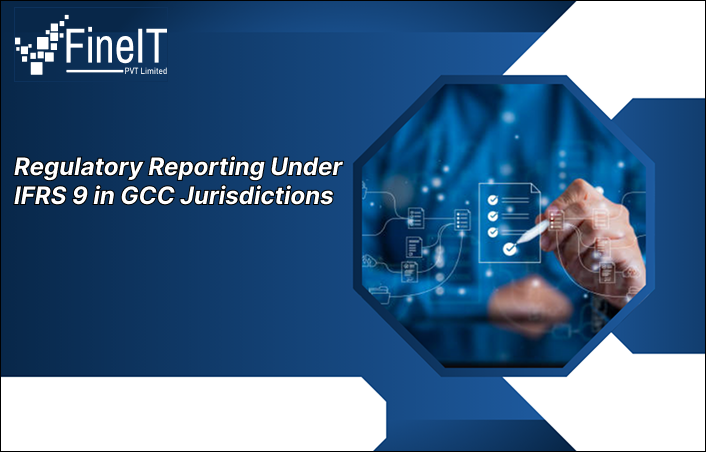IFRS 9, issued by the International Accounting Standards Board (IASB), has fundamentally transformed the way financial institutions measure and report credit risk. For banks and financial institutions in the Gulf Cooperation Council (GCC) — comprising Saudi Arabia, UAE, Qatar, Kuwait, Bahrain, and Oman — regulatory reporting under IFRS 9 is not just a compliance requirement but a strategic imperative. Regulatory authorities in the GCC have incorporated IFRS 9 into their supervisory frameworks to promote financial stability, transparency, and risk-based oversight.
IFRS 9 Framework Overview
IFRS 9 is structured around three key pillars:
1. Classification and Measurement
Financial assets are classified based on:
- The business model under which assets are managed
- Whether cash flows are solely payments of principal and interest (SPPI)
Assets fall into categories such as amortized cost, fair value through other comprehensive income (FVOCI), or fair value through profit or loss (FVTPL).
2. Expected Credit Loss (ECL) Model
This forward-looking model requires recognition of credit losses based on changes in credit risk:
- Stage 1: 12-month ECL for performing assets
- Stage 2: Lifetime ECL for underperforming assets
- Stage 3: Lifetime ECL for impaired assets
Macroeconomic forecasting and scenario analysis are integral to ECL estimation.
3. Hedge Accounting
IFRS 9 allows better alignment of hedge accounting with risk management strategies, though many regulators focus less on this area in supervisory reporting.
Regulatory Landscape in the GCC
Each GCC country has its own regulatory authority overseeing IFRS 9 implementation:
| Country | Regulator |
| Saudi Arabia | Saudi Central Bank (SAMA) |
| UAE | Central Bank of the UAE & SCA |
| Qatar | Qatar Central Bank (QCB) |
| Kuwait | Central Bank of Kuwait (CBK) |
| Bahrain | Central Bank of Bahrain (CBB) |
| Oman | Central Bank of Oman (CBO) |
All these regulators have issued IFRS 9 implementation guidelines and reporting formats tailored to local banking sector risks, often harmonized with Basel III and other international frameworks.
Implementation of IFRS 9 in the GCC
Most GCC countries mandated IFRS 9 adoption by 2018. However, regulators have provided national-level guidance to ensure consistency in:
- Interpretation of complex areas like ECL modeling
- Use of forward-looking information
- Alignment with local accounting and risk management norms
In Islamic finance-heavy markets such as Saudi Arabia and the UAE, Shariah-compliant institutions were guided to align IFRS 9 with AAOIFI standards wherever feasible.
Key Regulatory Reporting Requirements
1. Disclosures and Templates
Banks are required to report:
- Stage-wise asset distribution
- Reconciliations of ECL allowances
- Credit quality metrics and transitions
Templates differ slightly across regulators but typically include:
- Sectoral breakdowns
- Collateral valuations
- Reconciliation of opening and closing ECLs
2. Risk-Based Supervision
Regulators use IFRS 9 data to:
- Assess capital adequacy
- Guide risk-based on-site inspections
- Review internal credit risk governance
3. Integration with ICAAP and Stress Testing
IFRS 9 ECLs feed into Internal Capital Adequacy Assessment Process (ICAAP) reports, enabling regulators to evaluate capital planning under stress scenarios.
Challenges in Regulatory Reporting
1. Data Quality and System Gaps
Banks in the GCC face challenges in collating historical and forward-looking data across fragmented systems.
2. Forward-Looking Information
Building reliable macroeconomic overlays for ECL modeling has been particularly difficult due to:
- Lack of long-term economic history
- High market volatility
- Limited third-party model providers
3. Model Governance
Regulators require banks to document, validate, and backtest their ECL models — a complex task especially for small to mid-sized institutions.
4. Dual Reporting Complexity
Differences often arise between IFRS-based reporting and regulatory capital reporting under Basel, requiring reconciliation mechanisms.
Country-Specific Practices (Comparative Analysis)
| Country | Unique IFRS 9 Regulatory Feature |
| SAMA | Conservative overlays on ECL; detailed guidance on macroeconomic adjustments |
| CBUAE | Periodic validation reports; expected disclosures in Pillar III |
| QCB | Strict templates and audit certification for IFRS 9 disclosures |
| CBK | Emphasis on provisioning for retail and SME segments |
| CBB | Flexibility for smaller banks; robust supervisory dialogue |
| CBO | Risk-based templates aligned with ECL stages |
These differences reflect each country’s risk appetite, market maturity, and degree of regulatory oversight.
Best Practices for Compliance
To meet both accounting and regulatory expectations, financial institutions should adopt the following:
- Robust Data Management: Centralize and cleanse data to ensure consistency across systems
- Model Risk Frameworks: Establish independent validation and governance procedures
- Automation: Leverage RegTech to streamline reporting and reduce manual errors
- Training and Awareness: Invest in capacity-building for finance, risk, and IT teams
- Audit Readiness: Maintain documentation trails and evidence for assumptions used in ECL models
Future Outlook
Regulators in the GCC are increasingly focused on enhancing the quality and granularity of IFRS 9 reporting. Future trends may include:
- Integration of climate risk into credit modeling
- More frequent regulatory stress testing
- Regional harmonization of templates for cross-border banks
- Emphasis on AI-driven risk analytics for credit loss modeling
Banks that invest in scalable, transparent, and auditable systems will be best placed to adapt to these changes.
Conclusion
Regulatory reporting under IFRS 9 software solution in the GCC is evolving into a cornerstone of banking supervision. It demands more than compliance — it requires strategic alignment of finance, risk, and governance functions. While challenges persist, especially around data quality and model validation, GCC regulators are progressively refining their expectations. Financial institutions must stay proactive in enhancing their systems, controls, and transparency to meet both local and international standards.



